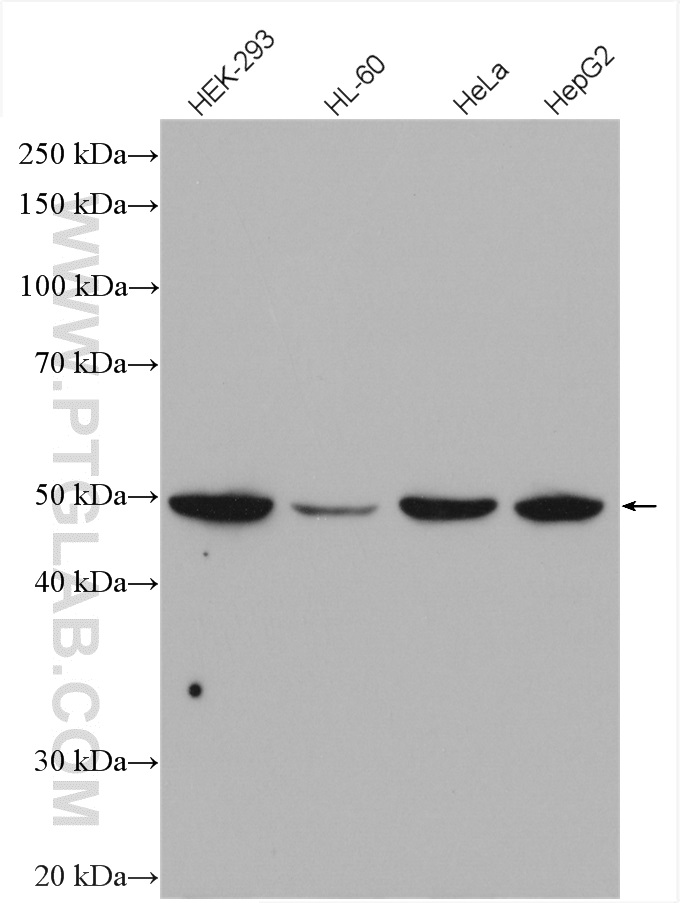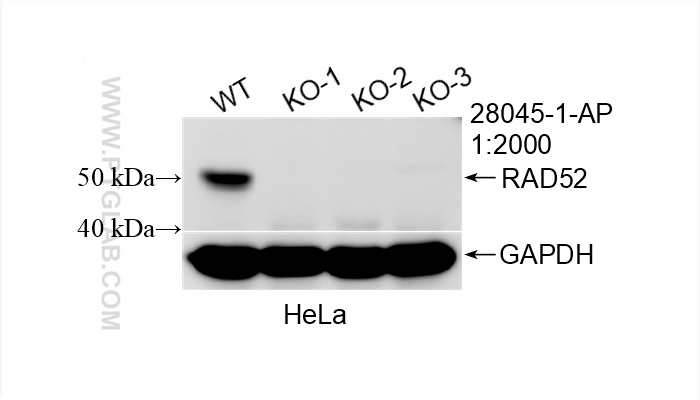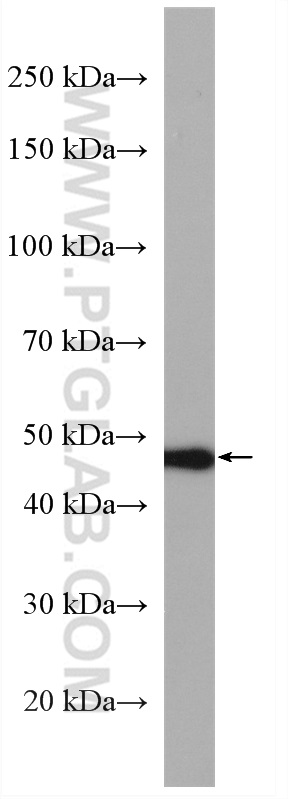验证数据展示
经过测试的应用
| Positive WB detected in | HEK-293 cells, HeLa cells, HL-60 cells, HepG2 cells |
| Positive IP detected in | HEK-293 cells |
推荐稀释比
| 应用 | 推荐稀释比 |
|---|---|
| Western Blot (WB) | WB : 1:1000-1:5000 |
| Immunoprecipitation (IP) | IP : 0.5-4.0 ug for 1.0-3.0 mg of total protein lysate |
| It is recommended that this reagent should be titrated in each testing system to obtain optimal results. | |
| Sample-dependent, Check data in validation data gallery. | |
发表文章中的应用
| KD/KO | See 2 publications below |
| WB | See 6 publications below |
产品信息
28045-1-AP targets RAD52 in WB, IP, ELISA applications and shows reactivity with human samples.
| 经测试应用 | WB, IP, ELISA Application Description |
| 文献引用应用 | WB |
| 经测试反应性 | human |
| 文献引用反应性 | human, pig |
| 免疫原 | RAD52 fusion protein Ag27619 种属同源性预测 |
| 宿主/亚型 | Rabbit / IgG |
| 抗体类别 | Polyclonal |
| 产品类型 | Antibody |
| 全称 | RAD52 homolog (S. cerevisiae) |
| 别名 | DNA repair protein RAD52 homolog |
| 计算分子量 | 46 aa |
| 观测分子量 | 46-50 kDa |
| GenBank蛋白编号 | NM_001297419 |
| 基因名称 | RAD52 |
| Gene ID (NCBI) | 5893 |
| RRID | AB_2881046 |
| 偶联类型 | Unconjugated |
| 形式 | Liquid |
| 纯化方式 | Antigen affinity purification |
| UNIPROT ID | P43351 |
| 储存缓冲液 | PBS with 0.02% sodium azide and 50% glycerol , pH 7.3 |
| 储存条件 | Store at -20°C. Stable for one year after shipment. Aliquoting is unnecessary for -20oC storage. |
实验方案
| Product Specific Protocols | |
|---|---|
| WB protocol for RAD52 antibody 28045-1-AP | Download protocol |
| IP protocol for RAD52 antibody 28045-1-AP | Download protocol |
| Standard Protocols | |
|---|---|
| Click here to view our Standard Protocols |
发表文章
| Species | Application | Title |
|---|---|---|
Sci Adv Deficiency in mammalian STN1 promotes colon cancer development via inhibiting DNA repair | ||
Int J Biochem Cell Biol Increasing CRISPR/Cas9-mediated homology-directed DNA repair by histone deacetylase inhibitors. | ||
Cell Death Dis SF3B4 promotes ovarian cancer progression by regulating alternative splicing of RAD52.
| ||
Nat Commun Pathway choice in the alternative telomere lengthening in neoplasia is dictated by replication fork processing mediated by EXD2's nuclease activity
|



